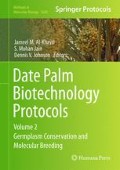Abstract
Investigation of genetic variation and phylogenetic relationships among date palm (Phoenix dactylifera L.) cultivars is useful for their conservation and genetic improvement. Various molecular markers such as restriction fragment length polymorphisms (RFLPs), simple sequence repeat (SSR), representational difference analysis (RDA), and amplified fragment length polymorphism (AFLP) have been developed to molecularly characterize date palm cultivars. PCR-based markers random amplified polymorphic DNA (RAPD) and inter-simple sequence repeat (ISSR) are powerful tools to determine the relatedness of date palm cultivars that are difficult to distinguish morphologically. In this chapter, the principles, materials, and methods of RAPD and ISSR techniques are presented. Analysis of data generated from these two techniques and the use of these data to reveal phylogenetic relationships among date palm cultivars are also discussed.
Access this chapter
Tax calculation will be finalised at checkout
Purchases are for personal use only
References
Haider N, Nabulsi I, MirAli N (2012) Phylogenetic relationships among date palm (Phoenix dactylifera L.) cultivars in Syria using RAPD and ISSR markers. J Plant Biol Res 1(2):12–24
Williams KJ, Kubelik A, Livak K, Rafalski JA, Tingey SV (1990) DNA polymorphism amplified by arbitrary primers are useful as genetic markers. Nucleic Acids Res 18:6531–6535
Micheli MR, Bova R, Pascale E, Ambrosio ED (1994) Reproducible DNA fingerprints with the random amplified polymorphic DNA (RAPD) method. Nucleic Acids Res 22:1921–1922
Kumar NS, Gurusubramanian G (2011) Random amplified polymorphic DNA (RAPD) markers and its applications. Sci Vision 11(3):116–124
Ng WL, Tan SG (2015) Inter-simple sequence repeat (ISSR) markers: are we doing it right? ASM Sci J 9(1):30–39
Zietkiewicz E, Rafalski A, Labuda D (1994) Genome fingerprinting by simple sequence repeat (SSR)-anchored polymerase chain-reaction amplification. Genomics 20(2):176–183
Gupta M, Chyi Y-S, Romero-Severson J, Owen JL (1994) Amplification of DNA markers from evolutionarily diverse genomes using single primers of simple-sequence repeats. Theor Appl Genet 89:998–1006
Karim K, Chokri B, Amel H, Wafa H, Richid H, Nouredine D (2010) Genetic diversity of Tunisian date palm germplasm using ISSR markers. Int J Bot 6(2):182–186
Al-Issa AM, Al-Helal AA, Al-Saad FA (2008) DNA fingerprinting analysis for three date palm Phoenix dactylifera L. cultivars grown at Al-Ahsa and Al-Qatif in Saudi Arabia using (ISSR-PCR) technique. Magazine of Abd-Al-Aziz King. Astrol Environ Sci Agric Dry Lands 19(1):3–21
Doyle JJ, Doyle JL (1987) A rapid DNA isolation procedure for small quantities of fresh leaf tissue. Phytochem Bull 19:11–15
Bioinfoweb. Preparation of 5× TBE electrophoresis buffer. Available via the INTERNET. http://bioinfoweb.com/Protocol-preparation-of-5X-TBE-electrophoresis-buffer.htm. Accessed 14 Oct 2015
STATSOFT Inc. (2003) STATISTICA (data analysis software system), version 6. http://www.statsoft.com
Haymes KM, Ibrahim IA, Mischke S, Scott DL, Saunders JA (2004) Rapid isolation of DNA from chocolate and date palm tree crops. J Agric Food Chem 52(17):5456–5462
Arif IA, Bakir MA, Khan HA, Ahamed A, Al Farhan AH, Al Homaidan AA et al (2010) A simple method for DNA extraction from mature date palm leaves: impact of sand grinding and composition of lysis buffer. Int J Mol Sci 11(9):3149–3157
Gaikwad AB (a) DNA quality: electrophoresis, spectrophotometry and fluorometry. Available via the INTERNET. http://www.nbpgr.ernet.in/Portals/6/DMX/GENOMIC_RESOURCES/DNA%20qualityspectrophotometry%20and%20electrophoresis.pdf. Accessed 6 Dec 2015
Addgene. Agarose gel electrophoresis. Available via the INTERNET. https://www.addgene.org/plasmid-protocols/gel-electrophoresis/Sigma.Product information.https://www.sigmaaldrich.com/content/dam/sigma-aldrich/docs/Sigma/Product_Information_Sheet/a1542pis.pdf. Accessed 1 Nov 2015
Gaikwad AB (b) PCR amplification assays: RAPD. Available via the INTERNET. http://www.nbpgr.ernet.in/Portals/6/DMX/GENOMIC_RESOURCES/PCR%20amplification%20assays-RAPD.pdf. Accessed 1 Oct 2015
Oxford Genetics. TAE and TBE Electrophoresis Buffers. Available via the INTERNET. http://oxfordgenetics.com/cloning-resources/cloning-buffers-andrecipes/tae-and-tbe-buffers. Accessed 1 Nov 2015
Van de Peer YV (2009) Phylogenetic inference based on distance methods: theory. In: Lemey P, Salemi M, Vandamme A-M (eds) The phylogenetic handbook: a practical approach to phylogenetic analysis and hypothesis testing. Cambridge University Press, Cambridge, pp 142–160
Acknowledgments
Many thanks to the Director General of AEC of Syria and Head of Department for their support.
Author information
Authors and Affiliations
Corresponding author
Editor information
Editors and Affiliations
Rights and permissions
Copyright information
© 2017 Springer Science+Business Media LLC
About this protocol
Cite this protocol
Haider, N. (2017). Determining Phylogenetic Relationships Among Date Palm Cultivars Using Random Amplified Polymorphic DNA (RAPD) and Inter-Simple Sequence Repeat (ISSR) Markers. In: Al-Khayri, J., Jain, S., Johnson, D. (eds) Date Palm Biotechnology Protocols Volume II. Methods in Molecular Biology, vol 1638. Humana Press, New York, NY. https://doi.org/10.1007/978-1-4939-7159-6_14
Download citation
DOI: https://doi.org/10.1007/978-1-4939-7159-6_14
Published:
Publisher Name: Humana Press, New York, NY
Print ISBN: 978-1-4939-7158-9
Online ISBN: 978-1-4939-7159-6
eBook Packages: Springer Protocols

